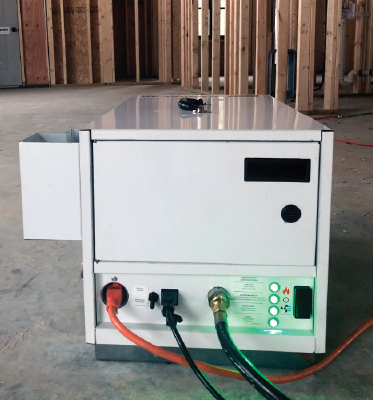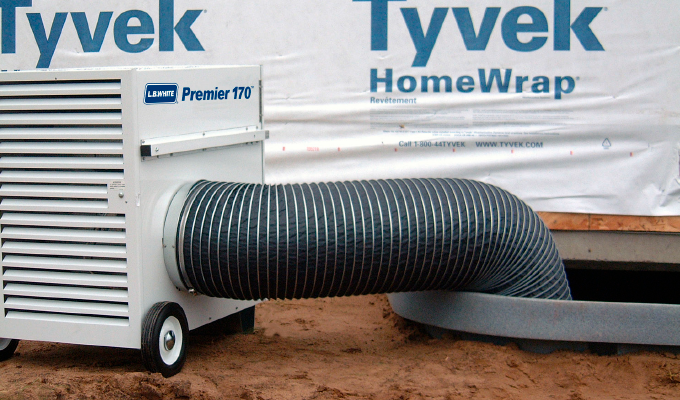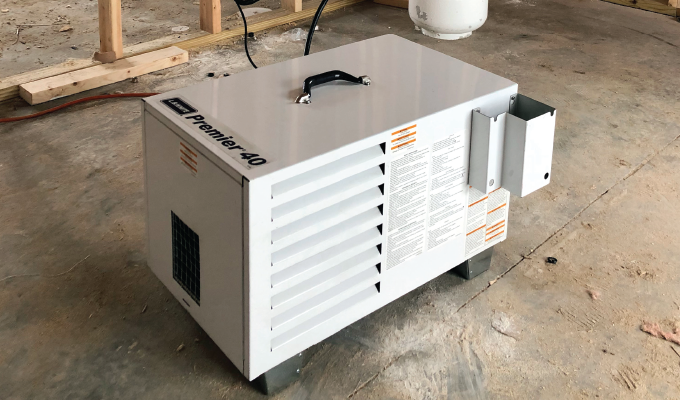Portable heat can be a vital tool to limiting the seasonality of construction projects. Year-round uptime is possible when portable heat is available to protect material investments and increase worker comfort. Over the years, portable heat has become more sophisticated and specialized. Thirty years ago, low-cost convection heat, basically a flame in a can, was popular. Now, portable heaters incorporate diagnostics and more safety features, ensure a clean burn, and can be used more strategically throughout a jobsite.
HEAT TECHNOLOGY
Direct-fired heat technology remains popular because it provides 99 percent fuel efficiency. Air comes in direct contact with the process of combustion for max heat output. For every $1.00 spent on fuel, direct-fired heaters are designed to convert $0.99 to heat output.

ADEQUATE EXCHANGE AIR
One square inch of fresh, exchange air is required for every 1,000 BTU of heated air output by direct-fired heaters to avoid buildup of combustion byproducts. Cracking a standard door 2 inches is about 160 square inches, which can provide enough exchange air for a 160,000 BTU/hr heater. Accessing adequate exchange air is often easy on jobsites where spaces are not sealed during most phases of construction. For those environments that are fully sealed spaces with no access to exchange air, like manholes and underground mines, direct-fired heat should not be used.
FLAME COMBUSTION
Most portable heaters use combustion involving a flame. Combustion occurs when oxygen and fuel combine in a reaction that produces heat. Direct-fired heaters that do not conceal the flame like portable forced air gas and kerosene heaters are considered open flame. When a flame is visible there is potential for interaction with combustibles in an environment—like stray plastic sheeting or saw dust on construction jobsites.
FIRST TO MARKET
In the 1990s, L.B. White introduced the first enclosed flame portable heater to the construction market. Enclosing the process of combustion separates the flame from the environment while still providing 99 percent fuel efficiency. By enclosing the flame and adding a fan to the design, flex duct can be attached to L.B. White Premier® heaters to move heated air from point A to point B. Indirect-fired heaters have an enclosed the flame and can be ducted, too, but are typically 0-25 percent less fuel efficient.
NEW FROM L.B. WHITE
The new Premier 40 portable heater from L.B. White offers the ultimate combination of efficiency and convenience. It is the smallest enclosed-flame direct-fired heater currently on the market offering 40,000 BTU/hr output and ultimate portability at 53 pounds. It can run on a single 20 lb LP tank for 6-8 hours in many scenarios and draws only a single amp when running continuously. It is made here in the U.S. and is backed by a 2-year warranty and lifetime of technical support. The Premier 40 is easy to transport, fuel, and power, so fits many general contracting needs and is easy to get up and running when unanticipated heat needs pop-up.

CLOSING THOUGHT
A few key variables determine the amount of heat needed for a space: cubic feet of the environment, desired rise in temperature, and amount of insulation in the space, if any. When shopping for heat you may notice some retailers focus on the square feet a heater can handle. Square footage does not consider critical factor of height of the space.
For more information:
To quickly calculate the amount of BTU/hr needed for your environment, check out this free heat estimator app at www.lbwhite.com/heatestimator. Be sure to check out other L.B. White products like the Premier® 40 portable heater.
Modern Contractor Solutions, September 2020
Did you enjoy this article?
Subscribe to the FREE Digital Edition of Modern Contractor Solutions magazine.



